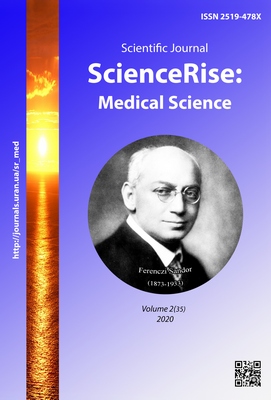Levels of specific IgE to auto-strains of s.aureus isolated from locus morbi patients with allergodermatosis
DOI:
https://doi.org/10.15587/2519-4798.2020.198931Keywords:
allergic dermatoses, clinical course, specific IgEAbstract
The aim: to determine the levels of specific IgE for S. aureus autostrains isolated from locus morbi with allergic dermatoses.
Research methods: the study included 81 patients who received medical care in the Department of Dermatology, State Institution “Institute of Dermatology on Venereology of the National Academy of Medical Sciences of Ukraine” in 2016-2019. The patients underwent clinical and laboratory examination, which included analysis of complaints and medical history data, assessment of the severity of the disease according to the SCORAD and EASI scales, and bacteriological and immunological studies. Examination of patients was carried out during an exacerbation of the disease.
Results of the study: a correlation was established between the indicators of specific humoral immunity and the clinical course of allergic dermatoses. It was proved that in patients suffering from AD with severe and moderate disease with clinically significant SCORAD indices, IgE reactivity to СCAg auto Staph was significantly higher compared to specific IgE to СCAg reference Staph: 40,5±5,4 and 22,2±3,1 (P <0,01) and 14,9±1,02 and 11,4±1,07 (p<0,01), respectively. When summarizing the results obtained in the study of the blood sera of patients with severe and moderate IE with significant EASI indices, it was shown that the levels of anti-staphylococcal IgE to CCAg auto Staph were significantly higher when compared with serum IgE to CCAg reference Staph: 15,8±1,51 and 11, 7±0,96 (p<0,01) and 8,4±0,48 and 6,9±0,39 (P <0.02), respectively.
Conclusions: given that the determination of specific and total IgE in blood serum blood pressure is included in the clinical protocol for the provision of specialized and highly specialized medical care, and allergen-specific therapy is considered as a promising treatment method, the determination of specific IgE before СCAg auto Staph can provide a personalized approach for diagnosis and treatment allergic dermatoses, weighed down by staphylococcal abnormal colonization of the skin
References
- Flohr, C., Mann, J. (2013). New insights into the epidemiology of childhood atopic dermatitis. Allergy, 69 (1), 3–16. doi: http://doi.org/10.1111/all.12270
- Kapur, S., Watson, W., Carr, S. (2018). Atopic dermatitis. Allergy, Asthma & Clinical Immunology, 14 (S2). doi: http://doi.org/10.1186/s13223-018-0281-6
- Silverberg, J. I., Simpson, E. L. (2014). Associations of Childhood Eczema Severity. Dermatitis, 25 (3), 107–114. doi: http://doi.org/10.1097/der.0000000000000034
- Barbarot, S., Auziere, S., Gadkari, A., Girolomoni, G., Puig, L., Simpson, E. L. et. al. (2018). Epidemiology of atopic dermatitis in adults: Results from an international survey. Allergy, 73 (6), 1284–1293. doi: http://doi.org/10.1111/all.13401
- Hajar, T., Gontijo, J. R. V., Hanifin, J. M. (2018). New and developing therapies for atopic dermatitis. Anais Brasileiros de Dermatologia, 93 (1), 104–107. doi: http://doi.org/10.1590/abd1806-4841.20187682
- Egawa G, Kabashima K. Multifactorial skin barrier defіciency and atopic dermatitis: essential topics to prevent the atopic march. J Allergy ClinImmunol. 2016. 138(2):350- 358.e1. doi: 10.1016/j.jaci.2016.06.002
- Ionesku, M. A. (2014). Kozhnyi barer: strukturnye i immunnye izmeneniia pri rasprostranennykh bolezniakh kozhi. Rossiiskii allergologicheskii zhurnal, 2, 83–89.
- Manti, S., Chimenz, R., Salpietro, A., Colavita, L., Pennisi, P., Pidone, C. et. al. (2015). Atopic dermatitis: expression of immunological imbalance. Journal of Biological Regulators and Homeostatic Agents, 29 (2), 13–17.
- Werfel, T., Allam, J.-P., Biedermann, T., Eyerich, K., Gilles, S., Guttman-Yassky, E. et. al. (2016). Cellular and molecular immunologic mechanisms in patients with atopic dermatitis. Journal of Allergy and Clinical Immunology, 138 (2), 336–349. doi: http://doi.org/10.1016/j.jaci.2016.06.010
- Nyankovskyy, S. L., Nyankovska, O. S., Horodylovska, M. I. (2019). Atopic dermatitis is an important problem in current pediatrics. Child`S health, 14 (4), 250–255. doi: http://doi.org/10.22141/2224-0551.14.4.2019.174039
- Korostovtsev, D. S., Makarova, I. V., Reviakina, V. A., Gorlanov, I. A. (2000). Indeks SCORAD -obektivnyi i standartizovannyi metod otsenkiporazheniiakozhi pri atopicheskomdermatite. Allergologiia, 3, 39–43.
- Larsen, F. S., Hanifin, J. M. (2002). Epidemiology of atopic dermatitis. Immunology and Allergy Clinics of North America, 22 (1), 1–24. doi: http://doi.org/10.1016/s0889-8561(03)00066-3
- Prikaz No. 535 "Ob unifikatsii mikrobiologicheskikh (bakteriologicheskikh) metodov issledovaniia, primeniaemykh v kliniko-diagnosticheskikh laboratorіiakh lechebno-profilakticheskikh uchrezhdenii". MZ SSSR, 22.04.1985, 125.
- Lapach, S. N., Chubenko, A. V., Babich, P. N. (2002). Osnovnye printsipy primeneniia statisticheskikh metodov v klinicheskikh ispytaniiakh. Kyiv: Morion, 160.
Downloads
Published
How to Cite
Issue
Section
License
Copyright (c) 2020 Svetlana Dzhoraeva

This work is licensed under a Creative Commons Attribution 4.0 International License.
Our journal abides by the Creative Commons CC BY copyright rights and permissions for open access journals.
Authors, who are published in this journal, agree to the following conditions:
1. The authors reserve the right to authorship of the work and pass the first publication right of this work to the journal under the terms of a Creative Commons CC BY, which allows others to freely distribute the published research with the obligatory reference to the authors of the original work and the first publication of the work in this journal.
2. The authors have the right to conclude separate supplement agreements that relate to non-exclusive work distribution in the form in which it has been published by the journal (for example, to upload the work to the online storage of the journal or publish it as part of a monograph), provided that the reference to the first publication of the work in this journal is included.









